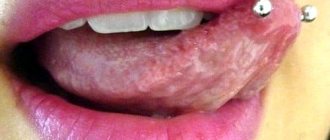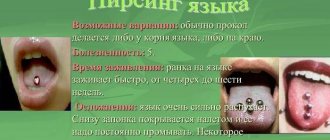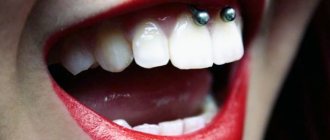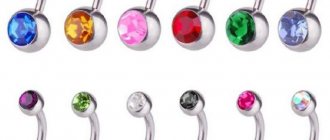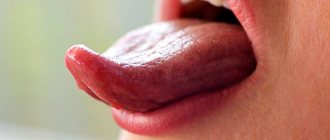History of tongue piercing
Since ancient times, piercings have been used by the indigenous people of America - the Mayans and Aztecs. To decorate the tongue they used earrings of various types. According to traditional beliefs, this type of piercing protected the wearer from evil spirits.
For a similar purpose, piercing was used by various peoples of Africa and Australia. The natives of these continents believed that a thorn in the tongue would drive out “evil spirits” that had penetrated a person.
The modern version of tongue piercing began to come into fashion in the early 1990s. Famous music performers made it popular. Since then, the fashion for tongue piercing has gone through several peaks of popularity and is currently experiencing a new wave of spread.
What to consider before the procedure
The main advantage of installing a tongue piercing is that it allows you to emphasize originality and highlight bright personality traits. With the right choice of decoration that will harmonize with the overall style, the aesthetics of the appearance will not be compromised. Another advantage is that the piercing is not located in a visible place and is not conspicuous.
This decoration of the tongue also has a number of disadvantages. The most significant include:
- At first, after installing a barbell or earring, problems with diction may occur. They are temporary and disappear within a few weeks after the procedure.
- Increased salivation may occur. This is the body's reaction to a metal object in the mouth.
- Distortions of taste. The metal rod can affect the perception of the taste of drinks and food.
- Damage to teeth. If the jewelry is installed incorrectly (too close to the edges of the tongue), it can damage tooth enamel and scratch the gums.
It is important to carefully weigh the pros and cons before making the final decision about getting a tongue piercing. It is especially important to analyze the opinions of others, since not all people perceive such jewelry positively. This can significantly affect career growth and social status.
Initial risks
Anyone who wants to have a tongue or lip piercing needs to understand that after creating a puncture, a wound surface is formed, which requires careful care. It must be remembered that the mouth is an ideal environment for the proliferation of pathogenic bacteria (humidity, temperature, small pieces of food and plaque). Therefore, the wound can take a very long time to heal. Even without hygiene and asepsis, there is a high probability of infection and the development of purulent-inflammatory processes that can spread to nearby tissues.
Important ! An infection can be acquired by having an oral piercing performed by an unscrupulous specialist who violates the rules of asepsis and uses a poorly processed instrument. And we’re not just talking about suppuration of tissues, accompanied by redness, pain, discharge of pus, bad breath, deterioration in general well-being and high fever. This way you can become infected with HIV, hepatitis B and C.
It is important to note that during the first 3-5 days after the puncture, the tissues swell, turn red, may bleed, and become very sensitive. The tongue may increase in size, which negatively affects the pronunciation of sounds, chewing and swallowing food. Painful reactions occur to hot and cold, spicy and sour foods, as well as simply when moving a muscle organ.
If the specialist has insufficient experience, during the puncture you may encounter severe tissue trauma, after which it will take a long time to heal and become scarred, that is, an unsightly scar will remain on them. But that's not all the consequences. It is much more unpleasant and dangerous if the puncture ends in damage to blood vessels and nerves, the development of neuralgia, and disruption of the motor activity of a muscle organ.
At what age can you get a piercing?
At your own discretion, you can undergo the procedure of installing jewelry from the age of 18. But you can get a piercing earlier – from the age of 14. This will require written permission from parents or guardians.
According to medical data, there is no need to rush into getting a piercing. The growing body of a teenager does not tolerate the introduction of foreign objects well, so it is better to postpone such procedures until adulthood.
How is tongue piercing done?
Most often, the procedure is performed under local anesthesia. Consists of the following stages:
- Thorough disinfection of the installation site for decoration and instruments.
- The site of the future puncture is anesthetized by applying a surface anesthetic or introducing it into the tongue by injection.
- The tongue is fixed using a special clamp.
- The master makes a puncture and installs the primary rod using a special catheter.
The procedure ends with rinsing the mouth with an antiseptic solution, usually furatsilin is used. It is important to consider that there are a number of medical contraindications to the procedure. These include: hypertension, heart disease, blood clotting problems, oral infections, epilepsy.
There are several ways to pierce your tongue. The most popular options are:
- Vertical puncture. The decoration is installed in the center of the tongue, a few millimeters from the frenulum.
- Puncture of the tip of the tongue. A small ring or earring is placed in a small hole near the tip of the tongue.
- Double puncture. Decorations are placed in the tongue in parallel or sequentially, depending on the wishes of the client.
- Multiple. The most complex variety, usually performed in several stages; decorations can be placed over the entire surface of the tongue.
- Frenum piercing. The least traumatic variety, but it greatly affects diction and is not suitable for people with a thin frenulum.
- Puncture of the uvula. The most extreme piercing, in which the jewelry is installed in the uvula of the soft palate.
It is important to understand that multiple and extreme types of piercings require careful and quite complex care and are not suitable for everyone.
What decorations can be used
The most popular options for tongue decorations include:
- Classic barbells. This is a straight cylindrical rod with decoration on the tips.
- Curved rods. Resembles the shape of a banana.
- Labrets. These are rods on which there is a disk on one side and a round clamp on the other.
- Rings and earrings. Typically used for insertion into the edges and tip of the tongue.
An important criterion is the material of the decoration. It is better to choose hypoallergenic metals such as gold and silver. A fairly universal and inexpensive solution is jewelry made of nickel-plated steel and brass. Another good alternative is a titanium barbell.
You should avoid tongue bars and earrings made of plastic and wood. Despite the very low price, they can contribute to the development of infectious complications and allergic reactions.
Pros and cons of piercing
Piercing has a number of advantages.
- The procedure is painless - pain during the puncture is practically not noticeable and is quite tolerable.
- Quick disguise - there are situations when an earring sticking out of the tongue is not at all appropriate, for example, during business negotiations or at an official reception. In this case, you can purchase a flesh-colored barbell.
- Psychological component - in some situations, piercing helps a person to assert himself, become more confident in himself and his own appearance.
- Easy removal - if you are tired of the stud, just remove it, and the hole will gradually close up.
Despite the large number of advantages, punctures have their downsides.
- Changes in diction - a person may begin to have a slight lisp or have difficulty pronouncing some sounds.
- Long healing after the procedure - after about 1-2 months, the tongue will get used to the foreign body and completely adapt to it.
- Disapproving reaction from relatives - unfortunately, not all close people will accept your choice, but on the contrary, they will dissuade you and ask you to get rid of such jewelry,
- Increased salivation - manifests itself in most cases.
- The risk of ingesting cloves increases during sleep, when a person does not control himself.
the puncture is almost painless
two tone piercing
Where can I get a piercing?
Despite the simplicity of the procedure, piercing installation should only be performed in a special salon by a qualified piercer. This is the only way to reliably reduce the risk of complications and side effects.
If the procedure is performed incorrectly at home by an unqualified technician, it is almost impossible to ensure sterility. This can lead to infection of the wound by various pathogens, including such dangerous ones as HIV and hepatitis C.
Possible complications
If the operation was performed poorly, the tongue will be very sore after the piercing. Signs of an inflammatory process (redness, severe swelling, itching) will begin to develop on the surface of the soft tissues. Healing of the wound surface will occur slowly.
Complications after piercing:
- heavy bleeding;
- infection of the wound surface;
- pain while eating, swallowing or communicating.
If negative consequences develop, an emergency visit to the doctor is necessary. Treatment of the inflammatory process consists of treating the wound surface with antibacterial and anti-inflammatory solutions. Your doctor may also prescribe antibacterial injections.
